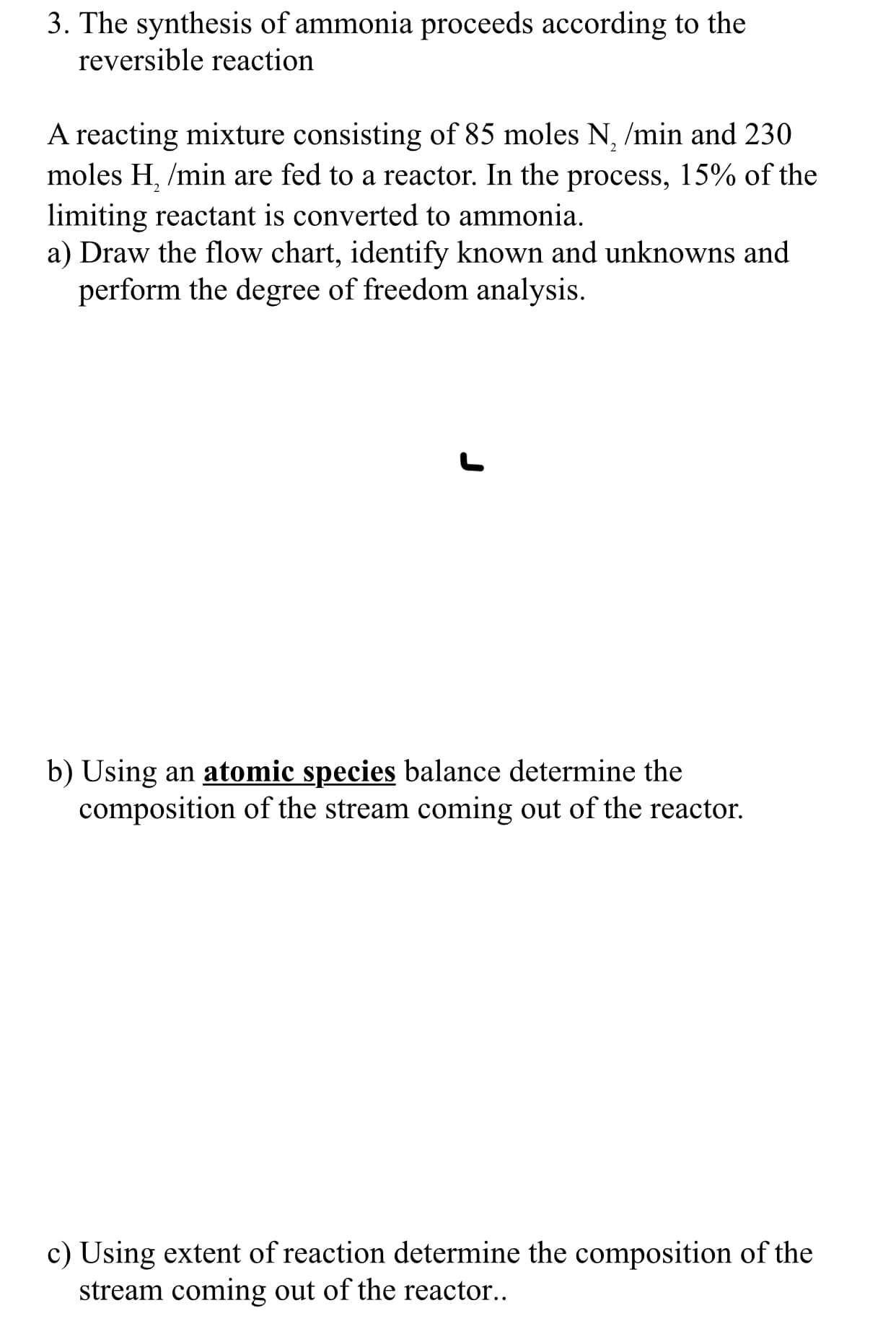3. The synthesis of ammonia proceeds according to the reversible reaction A reacting mixture consisting of 85 moles N, /min and 230 moles H. min are fed to a reactor. In the process. 15% of the limiting reactant is converted to ammonia a) Draw the flow chart, identify known and unknowns and perform the degree of freedom analysis b) Using an atomic species balance determine the composition of the stream coming out of the reactor c) Using extent of reaction determine the composition of the stream coming out of the reactor.
3. The synthesis of ammonia proceeds according to the reversible reaction A reacting mixture consisting of 85 moles N, /min and 230 moles H. min are fed to a reactor. In the process. 15% of the limiting reactant is converted to ammonia a) Draw the flow chart, identify known and unknowns and perform the degree of freedom analysis b) Using an atomic species balance determine the composition of the stream coming out of the reactor c) Using extent of reaction determine the composition of the stream coming out of the reactor.
Introduction to Chemical Engineering Thermodynamics
8th Edition
ISBN:9781259696527
Author:J.M. Smith Termodinamica en ingenieria quimica, Hendrick C Van Ness, Michael Abbott, Mark Swihart
Publisher:J.M. Smith Termodinamica en ingenieria quimica, Hendrick C Van Ness, Michael Abbott, Mark Swihart
Chapter1: Introduction
Section: Chapter Questions
Problem 1.1P
Related questions
Question
100%
In

Transcribed Image Text:3. The synthesis of ammonia proceeds according to the
reversible reaction
A reacting mixture consisting of 85 moles N, /min and 230
moles H. min are fed to a reactor. In the process. 15% of the
limiting reactant is converted to ammonia
a) Draw the flow chart, identify known and unknowns and
perform the degree of freedom analysis
b) Using an atomic species balance determine the
composition of the stream coming out of the reactor
c) Using extent of reaction determine the composition of the
stream coming out of the reactor.
Expert Solution
This question has been solved!
Explore an expertly crafted, step-by-step solution for a thorough understanding of key concepts.
This is a popular solution!
Trending now
This is a popular solution!
Step by step
Solved in 8 steps with 8 images

Knowledge Booster
Learn more about
Need a deep-dive on the concept behind this application? Look no further. Learn more about this topic, chemical-engineering and related others by exploring similar questions and additional content below.Recommended textbooks for you

Introduction to Chemical Engineering Thermodynami…
Chemical Engineering
ISBN:
9781259696527
Author:
J.M. Smith Termodinamica en ingenieria quimica, Hendrick C Van Ness, Michael Abbott, Mark Swihart
Publisher:
McGraw-Hill Education

Elementary Principles of Chemical Processes, Bind…
Chemical Engineering
ISBN:
9781118431221
Author:
Richard M. Felder, Ronald W. Rousseau, Lisa G. Bullard
Publisher:
WILEY

Elements of Chemical Reaction Engineering (5th Ed…
Chemical Engineering
ISBN:
9780133887518
Author:
H. Scott Fogler
Publisher:
Prentice Hall

Introduction to Chemical Engineering Thermodynami…
Chemical Engineering
ISBN:
9781259696527
Author:
J.M. Smith Termodinamica en ingenieria quimica, Hendrick C Van Ness, Michael Abbott, Mark Swihart
Publisher:
McGraw-Hill Education

Elementary Principles of Chemical Processes, Bind…
Chemical Engineering
ISBN:
9781118431221
Author:
Richard M. Felder, Ronald W. Rousseau, Lisa G. Bullard
Publisher:
WILEY

Elements of Chemical Reaction Engineering (5th Ed…
Chemical Engineering
ISBN:
9780133887518
Author:
H. Scott Fogler
Publisher:
Prentice Hall


Industrial Plastics: Theory and Applications
Chemical Engineering
ISBN:
9781285061238
Author:
Lokensgard, Erik
Publisher:
Delmar Cengage Learning

Unit Operations of Chemical Engineering
Chemical Engineering
ISBN:
9780072848236
Author:
Warren McCabe, Julian C. Smith, Peter Harriott
Publisher:
McGraw-Hill Companies, The